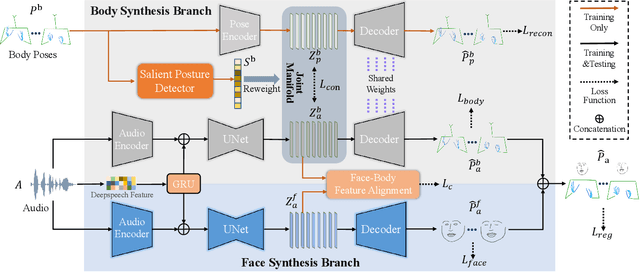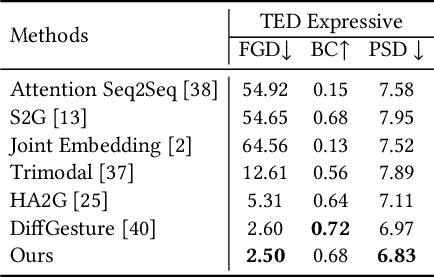Hexiang Wang
Emphasizing Semantic Consistency of Salient Posture for Speech-Driven Gesture Generation
Oct 17, 2024



Abstract:Speech-driven gesture generation aims at synthesizing a gesture sequence synchronized with the input speech signal. Previous methods leverage neural networks to directly map a compact audio representation to the gesture sequence, ignoring the semantic association of different modalities and failing to deal with salient gestures. In this paper, we propose a novel speech-driven gesture generation method by emphasizing the semantic consistency of salient posture. Specifically, we first learn a joint manifold space for the individual representation of audio and body pose to exploit the inherent semantic association between two modalities, and propose to enforce semantic consistency via a consistency loss. Furthermore, we emphasize the semantic consistency of salient postures by introducing a weakly-supervised detector to identify salient postures, and reweighting the consistency loss to focus more on learning the correspondence between salient postures and the high-level semantics of speech content. In addition, we propose to extract audio features dedicated to facial expression and body gesture separately, and design separate branches for face and body gesture synthesis. Extensive experimental results demonstrate the superiority of our method over the state-of-the-art approaches.
Solve paint color effect prediction problem in trajectory optimization of spray painting robot using artificial neural network inspired by the Kubelka Munk model
Sep 06, 2024



Abstract:Currently, the spray-painting robot trajectory planning technology aiming at spray painting quality mainly applies to single-color spraying. Conventional methods of optimizing the spray gun trajectory based on simulated thickness can only qualitatively reflect the color distribution, and can not simulate the color effect of spray painting at the pixel level. Therefore, it is not possible to accurately control the area covered by the color and the gradation of the edges of the area, and it is also difficult to deal with the situation where multiple colors of paint are sprayed in combination. To solve the above problems, this paper is inspired by the Kubelka-Munk model and combines the 3D machine vision method and artificial neural network to propose a spray painting color effect prediction method. The method is enabled to predict the execution effect of the spray gun trajectory with pixel-level accuracy from the dimension of the surface color of the workpiece after spray painting. On this basis, the method can be used to replace the traditional thickness simulation method to establish the objective function of the spray gun trajectory optimization problem, and thus solve the difficult problem of spray gun trajectory optimization for multi-color paint combination spraying. In this paper, the mathematical model of the spray painting color effect prediction problem is first determined through the analysis of the Kubelka-Munk paint film color rendering model, and at the same time, the spray painting color effect dataset is established with the help of the depth camera and point cloud processing algorithm. After that, the multilayer perceptron model was improved with the help of gating and residual structure and was used for the color prediction task. To verify ...
Continuous Piecewise-Affine Based Motion Model for Image Animation
Jan 17, 2024Abstract:Image animation aims to bring static images to life according to driving videos and create engaging visual content that can be used for various purposes such as animation, entertainment, and education. Recent unsupervised methods utilize affine and thin-plate spline transformations based on keypoints to transfer the motion in driving frames to the source image. However, limited by the expressive power of the transformations used, these methods always produce poor results when the gap between the motion in the driving frame and the source image is large. To address this issue, we propose to model motion from the source image to the driving frame in highly-expressive diffeomorphism spaces. Firstly, we introduce Continuous Piecewise-Affine based (CPAB) transformation to model the motion and present a well-designed inference algorithm to generate CPAB transformation from control keypoints. Secondly, we propose a SAM-guided keypoint semantic loss to further constrain the keypoint extraction process and improve the semantic consistency between the corresponding keypoints on the source and driving images. Finally, we design a structure alignment loss to align the structure-related features extracted from driving and generated images, thus helping the generator generate results that are more consistent with the driving action. Extensive experiments on four datasets demonstrate the effectiveness of our method against state-of-the-art competitors quantitatively and qualitatively. Code will be publicly available at: https://github.com/DevilPG/AAAI2024-CPABMM.
Time-Continuous Energy-Conservation Neural Network for Structural Dynamics Analysis
Dec 16, 2020



Abstract:Fast and accurate structural dynamics analysis is important for structural design and damage assessment. Structural dynamics analysis leveraging machine learning techniques has become a popular research focus in recent years. Although the basic neural network provides an alternative approach for structural dynamics analysis, the lack of physics law inside the neural network limits the model accuracy and fidelity. In this paper, a new family of the energy-conservation neural network is introduced, which respects the physical laws. The neural network is explored from a fundamental single-degree-of-freedom system to a complicated multiple-degrees-of-freedom system. The damping force and external forces are also considered step by step. To improve the parallelization of the algorithm, the derivatives of the structural states are parameterized with the novel energy-conservation neural network instead of specifying the discrete sequence of structural states. The proposed model uses the system energy as the last layer of the neural network and leverages the underlying automatic differentiation graph to incorporate the system energy naturally, which ultimately improves the accuracy and long-term stability of structures dynamics response calculation under an earthquake impact. The trade-off between computation accuracy and speed is discussed. As a case study, a 3-story building earthquake simulation is conducted with realistic earthquake records.
 Add to Chrome
Add to Chrome Add to Firefox
Add to Firefox Add to Edge
Add to Edge